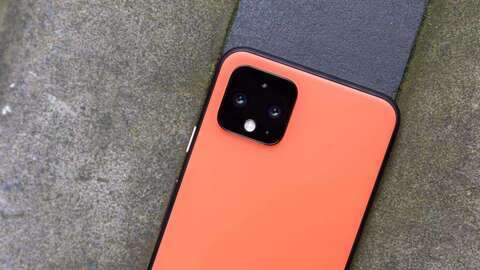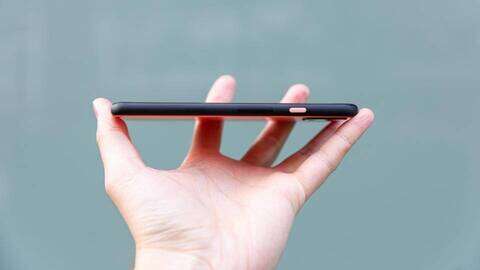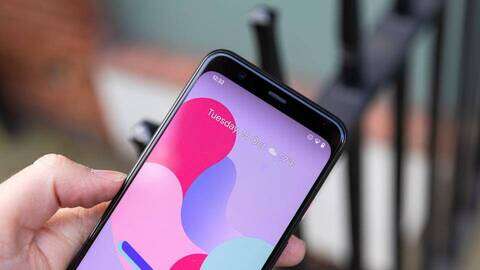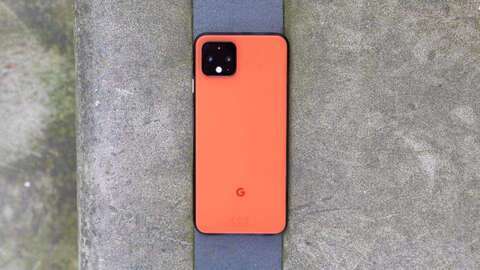Google Pixel 4 Google Pixel 4 review: A pixel-perfect encore?
It’s not often I’m left completely dumbfounded by the time I walk away from a keynote. The plentiful leaks might have helped soften the impact a little, but I fear Google is sorely resting on its laurels with the release of its latest pair of Android standard-bearers.
After all, half-heartedly slapping a secondary zoom camera on the Pixel 4 isn’t nearly enough of an upgrade to fully compete with the very best flagship smartphones that rival manufacturers can muster. Or is it?
READ NEXT: The best smartphones
Of course, the new camera – as boring as it may appear – isn’t the only alteration this year, although the Pixel 4’s pithy list of supplementary additions are perhaps even milder at first glance. Naturally, both new Pixels are powered by the more modern Qualcomm Snapdragon 855 processor , although this is soon to be superseded by the next-generation chip. And the radar-sensing gesture controls might be little more than a gimmick, rather than a must-have feature.
Buy now from Carphone Warehouse
Google Pixel 4 review: What you need to know
The Pixel 4 represents a series of firsts for Google. It’s the first Pixel phone with more than one rear-mounted camera, the first with a Snapdragon 855 and the first with a 90Hz screen. The company’s latest flagship handset also runs Android 10 (of course) and has a larger 5.7in screen with no notch.

Other new features include a motion-sensing radar chip embedded in the handset itself, which can detect whether you’re near the phone or not (more on that later), and the Pixel 4 has a new design, too.
Google Pixel 4 review: Price and competition
Mercifully, Google refuses to adopt the Apple model, ultimately charging upwards of four figures for its latest flagship handsets. The Pixel 4 can be picked up in two storage options, with the entry-level 64GB model costing £669 , while the 128GB variant costs £769 .
To cast those prices in a more positive light, the Pixel 4 is one of the cheapest flagship smartphones on the market. Apple’s iPhone 11 Pro starts at £1,049 , and the Samsung Galaxy S10 costs at least £800 .
Google Pixel 4 review: Design and key features
Regardless of whether or not the Pixel 4 represents a worthwhile upgrade or iterative flop, the first thing you’ll notice when you pull it out of the box is the updated design. Google has ditched the two-tone look of its previous three generations of flagships, and instead opted for a simpler single-tone colour scheme, available in a choice of three finishes: “Just Black”, “Clearly White” and, erm, “Oh So Orange”.

Whatever colour of Pixel 4 you decide to go for, each phone is surrounded by a softly-curved textured black trim, with a coloured power button and volume rocker on the right edge. There’s no notch on either handset this year either; instead the 8MP selfie camera and earpiece speaker are located inside a chunky forehead bezel.
Elsewhere, the Pixel 4 is sandwiched between protective layers of Gorilla Glass 5, rated to the IP68 standard. The new rear camera module – which is square in appearance – is distinctly iPhone-like , with the two cameras, infrared sensor and dual-LED flash arranged in a diamond pattern.
The dual front-facing speakers also reappear, and there’s still no 3.5mm headphone jack. This isn’t normally much of a problem, but ol’ miserly Google has decided not to include an adapter in the box this year. No matter how hard you look, there’s no fingerprint sensor either – not on the back of the phone or under the screen – but you can still unlock the Pixel 4 using your face, or with a PIN or pattern lock.
Speaking of which, let’s talk about the issues – and potential security vulnerabilities – with the Pixel 4’s face unlocking before we go any further. My review unit failed to register my face on a number of occasions, especially with my glasses off, and sometimes forgot the face data entirely, forcing me to go through the process of setting it all up again.

That’s a bit of a pain, of course, but without a doubt the biggest problem is that it’s possible to unlock the phone with your eyes closed. In theory, this means that someone could grab the phone while you’re asleep – or unconscious – and open your phone without you knowing.
Google says there’s currently a fix in the works, which should be deployed in the coming months, but until then I’d recommend to anyone who’s planning on picking up the Pixel 4 to ignore the face unlock setting entirely, and use a PIN, pattern or password lock instead.
Buy now from Carphone Warehouse
Google Pixel 4 review: Display
On a happier note, the Pixel 4’s screen has slightly grown in size by 0.2in – now measuring 5.7in from corner to corner – with a new refresh rate of 90Hz. It still has the same FHD+ resolution with support for HDR playback, however, and uses P-OLED technology.
Before I even had the chance to test the screen properly using our display colourimeter, it was obvious that there were no major colour accuracy issues – which was a problem with the Pixel 2 XL if you recall – so it was certainly off to a promising start.

In technical testing, I measured screen brightness peaking at 430cd/m2 in automatic brightness mode, promising readability in most sunny environments in the UK, although you might be squinting at your Facebook or Twitter feeds if you jet off somewhere more exotic.
The screen’s sRGB coverage in the phone’s “Natural” colour mode is at 90.5%, with a total volume of 90.5% (that’s very good). But the “Boosted” and “Adaptive” settings oversaturated the palette a bit too much for my liking, producing some garish, candy-looking colours.
Suffice it to say, this is a screen that’s very good for watching YouTube videos and playing games on, although the quality of the phone’s HDR playback really isn’t up to scratch. The Pixel 4 is simply unable to match the sheer brightness of the iPhone 11 Pro’s Super Retina XDR display, and scenes in Netflix’s Marco Polo series looked rather dark in comparison.
Google Pixel 4 review: Performance and battery life
Inside the Pixel 4 you’ll find a Qualcomm Snapdragon 855 processor and 6GB of RAM – up from the 4GB of last year. Both the Pixel 4 and 4 XL come with either 64GB or 128GB of internal storage, which you won’t be able to expand via microSD.
Unsurprisingly, this new processor delivers barnstorming benchmark results, and offers a slick, responsive experience all around. In the Geekbench 4 graphs below, you can see that the Pixel 4 performs better than its predecessor by quite a wide margin, and matches the Galaxy S10’s Exynos 9820 chipset in multi-core performance.
It’s a similar story for gaming and graphics performance, with the embedded Adreno 640 GPU delivering a higher framerate than the Galaxy S10 and iPhone 11 in the GFXBench on-screen Manhattan 3.0 test. Of course, this is mostly thanks to the addition of the 90Hz screen, but it’s nice to see that the GPU does manage to keep up, even if few games on the Google Play Store actually support higher frame rates.
Most importantly, however, I was hoping to see a major improvement in the Pixel 4’s stamina. Previous Google phones failed to provide more than a day’s worth of charge, but the bizarre decision to use a smaller 2,800mAh capacity battery didn’t fill me with confidence before I began my tests.
Unfortunately, there aren’t any gains in that department, with the Pixel 4 lasting a mere 12hrs 7mins in our standardised video rundown test. Looking at the numbers, that’s slightly worse than the Pixel 3’s result from last year, and is miles off the Galaxy S10 and iPhone 11’s longevity.
What does this mean for real-world battery life? Well, this is a phone that might just about make it through a day on a single charge, but you’ll have to be very conservative with what you do with it, and there certainly won’t be wiggle room to spare when you get home in the evening.
Of course, this isn’t the worst score we’ve ever recorded – that award goes to the Palm phone (3hrs 37mins) – but this certainly isn’t what we should expect from a flagship phone in 2019. With most high-priced phones reaching at least 20 hours under the same conditions, poor stamina shouldn't be dismissed; Google needs to do much, much better next year.
Buy now from Carphone Warehouse
Google Pixel 4 review: Android 10 and Soli
Arguably the most intriguing new feature is the Pixel 4’s gesture-based controls. Google says that it’s been working on this technology for five years now. It essentially uses a motion-sensing radar powered by a small custom "Soli" chip embedded into the handset itself, which detects motions around the phone.
Of course, a smartphone with gesture controls is hardly a new addition, but every other phone that’s done this before has previously relied on the camera tech, which is restricted to a field of view of up to 180-degrees. This new radar chip that the Pixel 4 is using allows you to interact with the phone from seemingly any angle.
As for practical implementations, the most useful application is when it comes to unlocking the phone, with the screen lighting up whenever the Pixel 4 detects movement and swiftly turning off the screen when it’s left alone. This should help speed up the unlocking process and, I’m told, improve battery life; that doesn’t seem to be the case.
As for other things you can do with the new radar chip, you can snooze alarms, skip songs on Spotify and cycle through your YouTube playlists with a nearby waggle of your hand. All of which is particularly useful if you’re cooking and your fingers are coated in brownie batter.
Naturally, Google is encouraging app developers to support the Pixel 4’s gesture controls, but at the time of release, there aren't many third-party applications to incorporate this feature.
As for software, the Pixel 4 is running the latest version of Google’s mobile operating system, Android 10, with its own Pixel launcher overlay. Android 10 is currently only available on a select few phones at the time of writing, and brings with it a handful of new features and software tweaks.
A system-wide dark mode is (finally) an option in Android 10, as well as a new “focus mode”, which hides notifications from apps you deem distracting. UI navigation has also changed slightly – there’s no more virtual navigation bar at the bottom of the screen, instead you move about with simple swipes. Swiping your thumb across from either side of the screen now acts as the back button, which I find particularly intuitive. Likewise, swiping up from the bottom of the screen brings you to the home screen, while swiping up and holding your finger in the middle of the screen for a brief second opens up a list of recent apps.
In fact, the user interface feels so well refined that I’d be willing to say that this is the best version of Android yet. And it finally manages to give iOS 13 a proper run for its money when it comes to both responsiveness and general speed.
Google Pixel 4 review: Camera
So far, the Pixel 4 is holding its own in most areas, but then so is every other flagship. True, it doesn’t cost as much as the four-figured handsets supplied by Samsung and Apple, but for the past few years there’s been an ace up Google’s metaphorical sleeves. There’s usually nothing better than a Pixel’s camera.
Google is well aware of this, and has decided to include the same 12-megapixel camera unit from previous years, which is now boosted by a new 16-megapixel 2x telephoto zoom camera. However, despite what Google’s heavy-handed marketing materials would have you believe, this isn’t particularly special – it simply allows you to zoom further into the frame. Besides, most phone makers have incorporated zoom lenses into its flagship portfolios for some time now.
So it appears Google isn’t offering much in the way of camera upgrades. With rivals such as the Mate 30 Pro and iPhone 11 Pro making big camera gains in recent months, Google’s prowess is in danger of being overtaken.
Buy now from Carphone Warehouse
But of course, the merits of the Pixel’s camera output aren’t judged solely by its meagre-looking hardware specifications. What’s particularly special is the processing that goes on behind the scenes, especially when it comes to the phone’s impressive HDR+ algorithms.
This isn’t something new, of course, and rather than drone on in great detail about how this system works, it’s worth noting that the Pixel 4’s image processing has been improved even further, with Google’s engineers improving the quality of the excellent “Night Sight” mode.
The colour balance of images captured in low-light – particularly in sky scenes – is much improved, and there’s now a brand-new dedicated astrophotography shooting mode, which should boost the quality of your images of the Milky Way. In this setting, Google says the Pixel 4 combines 15 long-exposure shots to create the best image possible, although you’re advised to stay away from urban areas and to pop your phone in a tripod or gimbal.
I haven’t had the opportunity to test this mode out in full just yet – such is the downside of living in central London – but stay tuned for my astrophotography camera samples in the coming weeks.
Elsewhere, you’re no longer left at the mercy of the HDR+ algorithms working their magic after you capture an image, as you now get a rough indication of what the image will look like before you press the shutter button, in the viewfinder itself. This also allows you to manually change the exposure of the foreground and background independently.
Let’s finally talk about the quality of the images that the Pixel 4 is capable of capturing, as I’m sure that’s what you’re waiting to hear about. I’m happy to report that the Pixel 4’s camera is as effortlessly versatile as it’s ever been – no matter the lighting conditions, you can rest assured that your pictures will be filled to the brim with intricate details, with well-judged exposures and a pleasingly-accurate colour rendition.
The Pixel 4 has the ability to seemingly capture colours as your own eyes see them. Images aren’t under or over-saturated, and there’s not much visual noise, even if you’re worried that there isn’t enough light in the environment.
Is it the best phone camera on the market? No, I think the iPhone 11 Pro slightly nudges ahead when it comes to sheer detail capture, especially if you compare the images taken using the 2x telephoto zoom cameras. Similarly, in medium to low-light, the Pixel 4 does a mighty fine job at brightening up shots without noticeably altering the colours, but the iPhone 11 Pro manages to do a much better job at lighting up the scene in near pitch-black environments.
The Pixel 4’s camera suite is very impressive, but again I think Google could have done better. That’s especially true when it comes to video recording – the Pixel 4 can shoot full-stabilised footage at 4K resolution, but if you slowly pan across the scene it sometimes gets a bit juddery in places.
Buy now from Carphone Warehouse
Google Pixel 4 review: Verdict
Phew. I certainly wasn't expecting to write this much about the Pixel 4 when I first powered up my laptop this morning. Looking back, my previous pessimistic statements about the Pixel 4 were perhaps a tad exaggerated, and it seems there is indeed plenty to talk about when it comes to Google’s latest flagship.
On paper at least, the Pixel 4 doesn’t seem to provide much that would warrant an upgrade. But as soon as you begin to dig deeper and start analysing the long list of small changes that you might have otherwise dismissed, you’ll find they all add up to something far greater.
It isn’t quite the phone I was hoping for, though, and while some of its issues like the lack of microSD support and the omission of the fingerprint reader could perhaps be justified, the potential security risks with the phone’s face unlocking are a much harder pill to swallow.
Does the Google Pixel 4 represent the very pinnacle of what Android can muster? Absolutely. Is it currently the best smartphone on the market? The answer to that question, I’m afraid, isn’t clear.
|
Google Pixel 4 specifications |
|
Processor |
Octa-core Qualcomm Snapdragon 855 (1x2.84GHz, 3x2.42GHz, 4x1.78GHz) |
|
RAM |
6GB |
|
Screen size |
5.7in |
|
Screen resolution |
2,280 x 1,080 |
|
Pixel density |
444ppi |
|
Screen type |
P-OLED |
|
Front camera |
8-megapixel (f/2.0) |
|
Rear camera |
12.2-megapixel (f/1.7), 16-megapixel 2x telephoto (f/2.4) |
|
Flash |
Dual-LED |
|
Dust and water resistance |
IP68 |
|
3.5mm headphone jack |
No |
|
Wireless charging |
Yes |
|
USB connection type |
USB Type-C |
|
Storage options |
64GB; 128GB |
|
Memory card slot (supplied) |
N/A |
|
Wi-Fi |
802.11ac |
|
Bluetooth |
5 |
|
NFC |
Yes |
|
Cellular data |
4G |
|
Dual SIM |
No |
|
Dimensions (WDH) |
147 x 69 x 8.2 mm |
|
Weight |
162g |
|
Operating system |
Android 10 |
|
Battery size |
2,800mAh |